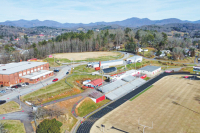Beyond the waterfalls: Asheville writer releases first written history of DuPont State Forest
 Biking is a popular pastime at DuPont. David Vance photo
Biking is a popular pastime at DuPont. David Vance photo
Danny Bernstein’s fascination with DuPont State Recreational Forest began soon after she moved to Asheville in 2001.
“The first hike I took in DuPont Forest was to High Falls,” Bernstein wrote in her new book DuPont Forest: A History. “Like other visitors, I gawked and stared at the falls as I clicked one shot after another. It was a spectacular waterfall. Then I turned around and spotted a tall chimney on a hill. I walked up the wooden steps and saw that the chimney had a fireplace on two sides. A date had been engraved in the concrete. No other clue, no plaque, no sign — I was not in a museum. But I knew there was a story here beyond the waterfalls.”
Bernstein started asking around. There are literally hundreds of books covering every aspect of the history of the nearby Great Smoky Mountain National Park. Surely there must be at least one telling DuPont’s story? But she could never find anything more than a smattering of articles.
“Nobody had put the whole story together,” she said.
She decided to do it, and The History Press released the resulting book this month. Bernstein is the author of four other published books, but this project would turn out to be much different from the others she’d tackled thus far. Two of her four previous titles are hiking guides, and two focus on the experiences to be had using public lands — one covers her 1,000-mile hike of the Mountains-to-Sea Trail and another takes readers inside each of the 71 National Park Service units in the Southeastern U.S.
“I’ve always been interested in the history of the land. Even in my conventional hiking guides I always dug into what happened there and the history, but this was very different in that it had to be a narrative,” she said.
Related Items
True to form, Bernstein’s research included joining Friends of DuPont Forest and hiking each of the forest’s trails. Some of those experiences did make it into the book, but its main goal is to tell the tale of how the land came to house a factory that became an economic powerhouse of the region, what it was like to work there, and how that industrial operation eventually gave way to the much-loved state forest in place today.
“I had to make it like a story,” she said.

Danny Bernstein.
The DuPont story
Luckily for Bernstein, the 10,400 acres that now comprise the state forest offered up plenty of stories spanning generations of characters.
The land’s recorded history stretches back to 1799, when Revolutionary War veteran John Thomas Jr. was given — as bounty land for his service — a tract that most likely included High Falls, Triple Falls and Bridal Veil Falls. In the early 1850s, John Thomas’ son Micajah built the Buck Forest Hotel at the intersection of present-day Cascade Road and Staton Road, entertaining guests traveling to the mountains from upstate South Carolina. After that, the land changed hands several times until 1910, when it was sold to Tench Charles Coxe and remained in the Coxe family thereafter. Another tract of land that would eventually become part of DuPont’s holdings, known as Guion Farm, was bought by engineer Alex Guion in 1951.
DuPont Corporation first turned its eye to Western North Carolina in the 1950s as it geared up to produce hyper pure silicon for the nascent semiconductor industry. The process required pure water and pure air, something the company was sure it could find in the mountains of WNC. In 1956 DuPont bought 5,359 acres from Frank Coxe and smaller owners in Transylvania County along with 5,411 acres from Alex Guion in Henderson County.
The plant soon became a successful and important part of the region’s economy. By 1958, it had an annual payroll of $1.5 million — the figure grew to $4 million by 1967 — offering locals the chance to work a steady job in exchange for high pay and top-tier benefits.
“Everyone was eager to get a job with DuPont,” Bernstein wrote. “The company was already well known for its high safety standards. Eager young men still in their teens were looking for their first job. Supplies were bought locally, which boosted the local economy. With $2.5 million of annual purchases, the company needed a professional purchasing agent.”

The ribbon is cut on Hubbard Field, a baseball field that opened in 1974 and was built atop buried waste from the plant. Chan Hubbard family photo
After purchasing the property, the company tore down the Buck Forest Lodge, which by then had become run down with “haphazard and unpredictable running water and electricity.” However, the DuPont Employees Recreation Association, formed in 1963 with management approval, soon began working for enhanced entertainment opportunities among the workforce. For $2 per year, employees could join an organization that offered families “a Kiddie Xmas party, Easter Egg hunt, DERA dance, Fishing in Little River, Hiking, Barn for horses, Picnic…And the list goes on.” In 1973, the company newsletter announced that a new lake would be built for employees, and two years later the lake opened complete with a 400-foot deck and 14 campsites.
By 1962, silicon was no longer a competitive product and the plant began to produce X-ray film instead.
“They had bought the land to make silicon, and silicon required good air and good water,” said Bernstein. “Once they switched to film, they didn’t need 10,000 acres, but they were very concerned about their neighbors. They were very concerned about other people polluting their streams upstream.”
In researching the book, one of Bernstein’s biggest surprises was learning that DuPont executives were talking, almost from the beginning of the venture, about what they should do with all the unneeded land. For decades, the company relied on logging to get the land the pay for itself and also realize a small profit, planting 500,000 white pine trees upon purchasing the property.
DuPont continued to produce X-ray film until 1995, when it announced it would sell the plant. The following January Sterling Diagnostic Imaging bought the 2,700 acres containing the factory, but the question was, what would happen to the rest of the land.
The plant’s life was coming to an end, but its death marked the birth of a new creation — Dupont State Recreational Forest. In 1997, DuPont sold 7,600 acres to The Conservation Fund for $2.2 million, a price that hung below market value and was considered a bargain sale. The Conservation Fund then transferred the land to the State of North Carolina.
Just two years later, Sterling Diagnostic sold 476 acres of the plant property to Agfa, but the remaining 2,223 acres were purchased by developer Jim Anthony for $6.35 million, higher than the state’s $5.5 million offer. Anthony planned to build houses on the property, but after prolonged public outcry the state took the title by eminent domain in October 2000.
Before long, the Agfa operation announced that it was closing the plant completely in order to consolidate operations in South Carolina. In 2002, the facility shut down for good. After Agfa tore down the buildings on site, cleanup responsibilities reverted back to DuPont. This property is now known as the “donut hole,” a chunk of private land surrounded by thousands of acres of public forest. One day, it’s likely to become part of the state forest. But with environmental cleanup efforts still continuing, it will remain private for the time being.

Triple Falls is one of DuPont State Recreational Forest’s Triple Falls is one of DuPont State Recreational Forest’s most well known waterfalls. Danny Bernstein photo
‘I just listen’
At the heart of Bernstein’s book are stories. Not stories pulled from a textbook or a magazine or even from old letters and journals, but rather stories gathered one by one from personal conversations with the people who lived them.
“Even though The History Press wanted to call it a history, I call it a memoir, because so much of it is depending on people’s memories,” said Bernstein. “Very little is officially written about DuPont.”
To gather these stories, Bernstein started by chatting with the people she shared the trail with on hikes with the Carolina Mountain Club. As her interest grew, she found herself setting up official interviews, traveling to people’s homes or else buying them lunch or coffee while they shared their memories.
Bernstein began attending a monthly breakfast for retired DuPont employees, held at a café between Hendersonville and Brevard and segregated “not by sex and not by race, but by whether you were an hourly employee or an engineer or chemist,” she said. Every time, said Bernstein, she was the only woman there — the plant was always a man’s workplace.
“I just listen,” she said. “Most of them don’t want to talk about the old days. They want to talk about what they’re doing now.”
Any interviews with the men from the breakfasts would take place elsewhere, during a separate meeting. That’s how she met one of her favorite interviews, a World War II veteran in his 90s named Earle Johnson who was likely the plant’s very first engineer. He told her about how the pipes froze his first year there after the temperature went down to negative 20 degrees. Johnson, who moved to Brevard from New Jersey, was in disbelief that the temperature could get that low this far south. After the interview, Bernstein checked National Water and Climate Center records and found that, indeed, the temperature in Brevard had dipped to negative 20 in February 1958.
“Years ago, when I told my parents that I was going to marry an engineer, my dad was thrilled,” Bernstein writes earlier in the book. “‘Engineers make the best husbands,’ he said, which at the time seemed absurd. But overall, engineers are smart, dedicated to their job, make a good salary and are too busy or indifferent to cheat. These are good odds for a successful marriage and a happy life. These are also good odds for a successful interview.”
After writing Dupont Forest: A History, Bernstein would know.
Learn more
Danny Bernstein will join author and Smoky Mountain News writer Holly Kays at 6 p.m. Thursday, Sept. 17, for a conversation about her new book DuPont Forest: A History, to be held via Zoom.
Offered by Malaprop’s Bookstore/Cafe, the event is free with registration. Bernstein’s book, as well as Kays’ titles Trailblazers and Traditionalists: Modern-Day Smoky Mountain People and Shadows of Flowers, are available for purchase at Malaprop’s.
Learn more or register at bit.ly/2ZhSRR7.









